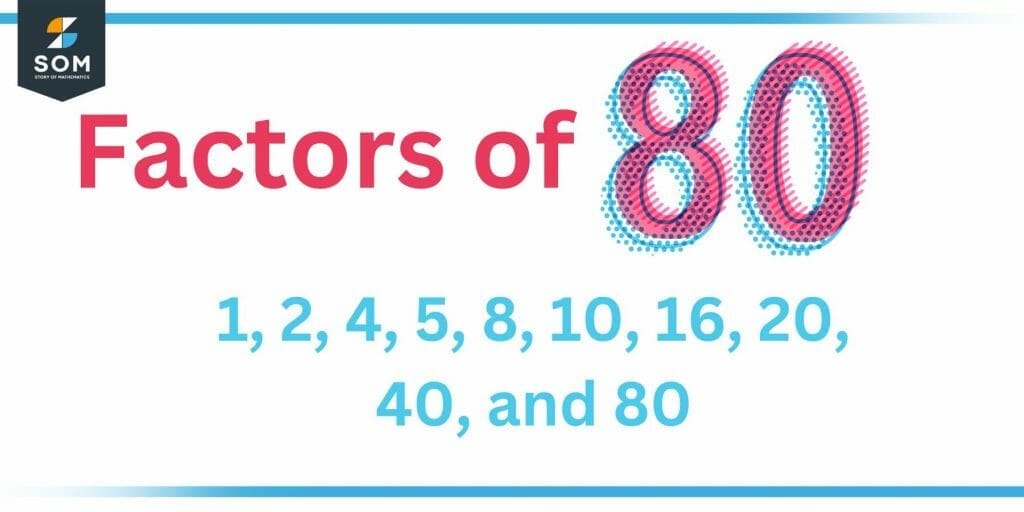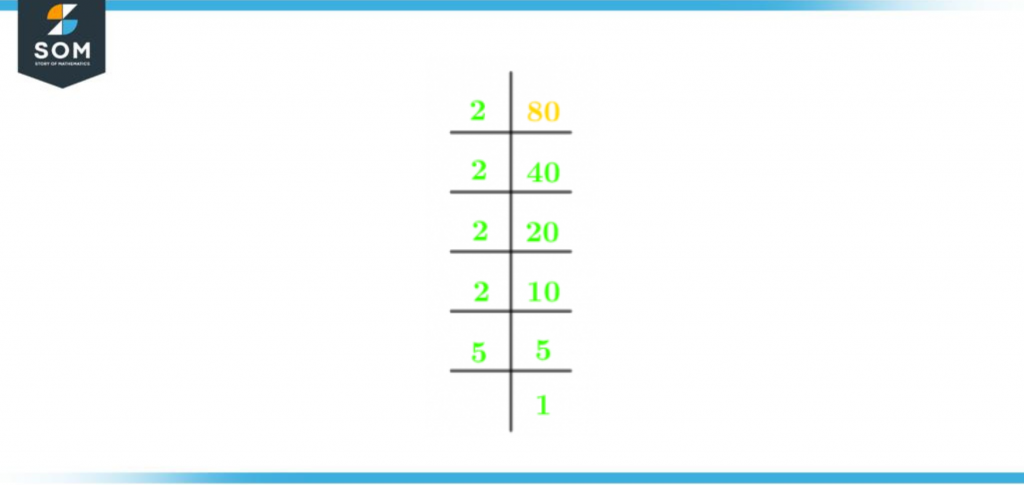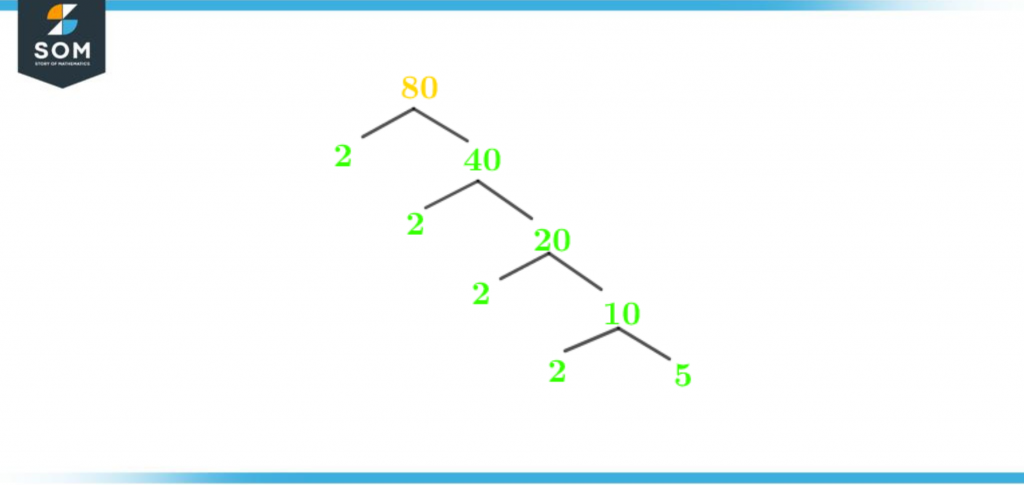JUMP TO TOPIC
Factors of 80: Prime Factorization, Methods, Tree, and Examples
The factor of 80 is a list of numbers. This list consists of only integers that divide the number 80 without leaving any remainder.
Figure 1 – All possible Factors of 80
What Are the Factors of 80?
The factors of 80 are the following: 1, 2, 4, 5, 8, 10, 16, 20, 40, and 80.All these numbers fulfill the condition of factors, which says that when 80 is divided by a number, the remainder should be zero. The fact that 80 is a composite number. If a number consists of more than two factors, it is known as a composite number.How To Calculate the Factors of 80?
You can calculate the factors of 80 by the division method and multiplication method. We will learn both techniques in this article.Discovering factors of 80 using a simple division method:Start dividing the given number 80, with the smallest integer. 1 is the smallest integer in a positive number line.\[ \dfrac {80}{1} = 80 \]1 is a factor of every integer because it divides every number. The remainder is zero. Hence proved that 1 is a factor of 80.80 is an even composite number, and it is divisible by 2.\[ \dfrac {80}{2} = 40 \]The remainder is again zero. Add 2 to the list of factors of 80.Divide 80 by 3:\[ \dfrac {80}{3} = 26.67 \]The remainder is not zero. The result is in decimal form, So 3 is not a factor of 80.We will now proceed to divide 80 by a series of numbers as given below:\[ \dfrac {80}{4} = 20 \]\[ \dfrac {80}{5} = 16 \]\[ \dfrac {80}{8} = 10 \]\[ \dfrac {80}{10} = 8 \]\[ \dfrac {80}{16} = 5 \]\[ \dfrac {80}{20} = 4 \]\[ \dfrac {80}{40} = 2 \]\[ \dfrac {80}{80} = 1 \]The remainder of all the above divisions is zero, and the quotients are an integer.Every number divides itself evenly. As a result, every number is a factor in itself. Hence, factors of 80 are the following: 1, 2, 4, 5, 8, 10, 16, 20, 40, and 80.Finding factors of 80 using a simple multiplication method:When the product of two numbers is 80, both numbers will be the factors of 80. Multiplier and multiplicand both should be in the range of 1-80.1 x 80 = 80
1 and 80 both are factors of 80.2 x 30 = 60
Product is not equal to 80. Condition not satisfied, so pair of 2 and 3 is not a factor of 80.2 x 40 = 80
2 and 40 are factors of 80 because their product is 80.Similarly, doing it for the rest of the numbers:4 x 20 = 80
5 x 16 = 80
8 x 10 = 80
By the above multiplications, we conclude the factors list of 80.Following is the list of factors of 80:Factors of 80 are the following: 1, 2, 4, 5, 8, 10, 16, 20, 40, and 80.Following is the list of negative factors of 80:Negative factors of 80 are the following: -1, -2, -4, -5, -8, -10, -16, -20, -40, and -80.Fun Facts
- Factors of a number can never be greater than the number itself.
- Negative factors of any number are the additive inverse of its positive factors.
- Factors are never in decimal or fraction form.
- Numbers having more than two factors are called composite numbers.
Factors of 80 by Prime Factorization
Prime factorization is a technique of writing a number in the form of the product of its prime factors. Prime factors are numbers that have two factors only. The number one and the number itself.The upside-down division is a method to find prime factors of 80.The upside-down division is simply done by dividing the composite number by its prime factors only. Start dividing 80 by the smallest prime factor present in the factors list of 80. Keep on dividing until the quotient becomes 1. Factors of 80 are the following: 1, 2, 4, 5, 8, 10, 16, 20, 40, and 80.The number 1 is not a prime number. 2 and 5 are prime factors. We always have to start the division by the smallest prime factor, So we will start dividing 80 by 2:\[ \dfrac {80}{2} = 40\]40 is also divisible by 2. So keep on dividing \[ \dfrac {40}{2} = 20 \]\[ \dfrac {20}{2} = 10 \]\[ \dfrac {10}{2} = 5 \]The number 5 is not divisible by 2, So divide it by the next prime factor. The next prime factor is 5:\[ \dfrac {5}{5} = 1 \]The figure below shows the upside-down division of 80:
Figure 2 – Prime Factorization of 80
2 x 2 x 2 x 2 x 5 = 80
Factor Tree of 80
A factor tree is a pictorial representation of factors of 80, mainly prime factors. The factor tree shows how factors are driven by a number. It is a special diagram that is easy to understand. The number whose factor tree is being constructed will be written at the top, and that number is branched into two factors. That factor is further split into its factors. This process goes on until division reaches the prime factors. We can also say the factor tree shows the basic flow of division.\[ \dfrac {80}{2} = 40\]The number 80 splits into 2 and 40. Where 2 is a prime number. So it wouldn’t be further branched. Only 40 will divide further.\[ \dfrac {40}{2} = 20\]Again the number 2 wouldn’t be further divided. Only split the number 20.\[ \dfrac {20}{2} = 10\]\[ \dfrac {10}{2} = 5\]Now the number 5 will be divided by 5, the quotient will be 1, and the division terminates.The following is the factor tree of 80:
Figure 3 – Factor Tree of 80
Factors of 80 in Pairs
Writing the sets of numbers when multiplied together gives us 80 are called factor pairs of 80. Writing factor pairs by using a simple trick. First, arrange the factors of 80 in ascending order:Factors of 80 in ascending order 1, 2, 4, 5, 8, 10, 16, 20, 40, and 80.Now pair them up. Pick one factor from the start of the list and pair it with its corresponding factor from the end of the factors list.Pair the first factor with the last factorFirst factor: 1Last factor: 80Factor pair: (1, 80)Second factor with the second-last factor. Second factor: 2Second last factor: 40Factor pair: (2, 40)Pick the third factor from the start of the list and pair it with the third last factor in the list:Third factor: 4Third-last factor: 20Factor pair: (4, 20)Pair the fourth factor from the start with the fourth last factor:Fourth factor: 5Fourth-last factor: 16Factor pair: (5, 16)Now pair the middle two factors:(8, 10)Similarly, find the negative factor pairs.The positive and negative factor pairs are given as:Positive Factor Pairs of 80 are given as:(1, 80) (2, 40) (4, 20) (5, 16) (8, 10)Negative Factor Pairs of 80 are given as: (-1, -80) (-2, -40) (-4, -20) (-5, -16) (-8, -10)Factors of 80 Solved Examples
Let’s solve some examples of factors of 80 for a better understanding.Example 1
Help Zoe to find prime factors of 8 and 80. Also, Find the common factors of 8 and 80.Solution
A list of factors of 8 is given as: 1, 2, 4, and 8A list of factors of 80 is given as:1, 2, 4, 5, 8, 10, 16, 20, 40, and 80Prime factors are the numbers that are only divisible by one and the number itself. Number 1 is not a prime number.List of prime factors of 8: 2.List of prime factors of 80: 2 and 5.Common factors are numbers that are present in both lists of factors. After comparing both factor lists, we take out the numbers that are part of both lists.List of common factors of 8 and 80: 1, 2, 4, and 8.Example 2
Peter made 80 paintings. He was selling those painting near a park. X number of the paintings sold out in 5 hours. Calculate the number of paintings sold.Solution
The total number of paintings Petter made: 80.The total paintings Petter sold: X.Total time in which X paintings sold: 5 hrs.80= 5 x X
Dividing both sides by 5:Paintings Petter sold in 5 hrs (X): \[ \dfrac {80}{5} = 16 \]Peter sold 16 paintings out of 80 in 5 hours.Images/mathematical drawings are created with GeoGebra.